New Stuff[hide]
Reportes: From The St... : Cubadisco 2...
Fotos: Tom Ehrlich
Staff: Kristina Lim
Musicos: Juan Formell
Musicos: Yordamis Megret Planes
Musicos: Yasser Morejón Pino
Musicos: José Luis "Changuito" Quintana...
Musicos: Dennis Nicles Cobas
Fotos: Eli Silva
Grupos: Ritmo Oriental : 1988 - Vol. IX - 30 a...
Musicos: Rafael Paseiro Monzón
Musicos: Jiovanni Cofiño Sánchez
Fotos: Tom Ehrlich : 2024 Monterey Jazz, P...
Resenas: Vacilón Santiaguero (Circle 9 ...
Photos of the Day [hide]
SpanishEnglishInterview - Pedro Pablo Gutiérrez
Part 1: Questions from Kevin Moore TIMBA.COM: How did you first become interested in music as a child and what was your musical education prior to playing professionally? PEDRO PABLO: I had music in my blood -- my father was a percussionist in the groups "Sensación" and Pancho el Bravo¹s "Las Estrellas Cubanas". As a child he took me to the concerts, which is how I began to become interested in music. Later I began studying cello at the Conservatorio Alejandro García Caturla at the elementary level. I continued later to the middle level at the Conservatorio Amadeo Roldán, where I graduated as a cellist. But I also learned to play the bass, which I liked so much that it became my main instrument.. TIMBA.COM: Around the time you started playing with Charanga Habanera, NG La Banda was starting to playing Timba in Cuba. What were your initial reactions to NG and its bassist, Feliciano Arango when they first hit the scene? PEDRO PABLO: The group NG La Banda became an example for the young musicians of the nineties because it caused a major transition in Cuban music. At that time CH was still playing traditional music. Feliciano Arango was the first bass player of the new generation. His playing style was imitated by all electric bass players of the moment. TIMBA.COM: We¹re already familiar with Charanga Habanera¹s early years, playing traditional music in Europe. But in 1991, the group made a dramatic change in its style which led to the album "Me Sube La Fiebre". This new music was completely different from what the band had been playing before, and also quite different from NG La Banda and Los Van Van. The new style that Charanga Habanera created wound up having a massive impact on all of the Cuban music that came after it. Can you explain how this change in style came about and where these exciting new musical ideas came from? TIMBA.COM: You were the first Timba bassist to play the "baby bass". How did you first start playing this instrument and how would you compare it to playing an acoustic upright bass? Also, have you ever played the electric bass? PEDRO PABLO: Yes, I have played the electric bass. It is not that I dislike it, but I enjoy playing the baby bass more because I find it has more flavor, or sabor, as we Cubans say. I also like playing the acoustic bass, but for Timba the dryer sound of the baby bass is needed. It has also certain rhythmic and timbral advantages, and a wider and more legato sound. TIMBA.COM: When Charanga Habanera changed its style from traditional Charanga to Timba, how did you change your bass style? And, in general, how did the role of the bass change in Timba, as compared to Salsa, Son, and other previous types of Latin dance music? PEDRO PABLO: The conversion of traditional Charanga into Timba was really not a change for me. What I did was only to carry on the traditional formulas of the bass playing style into Timba. I took the traditional playing style of the Son, the Mozambique, the Cha-Cha-Cha, and renewed it to form my own style. Compared to other types of music, the bass cell was very static, always the same. In Timba I introduce new rhythms and mix them. That's why my playing style is different. TIMBA.COM: We¹re very interested in how the final arrangements were worked out for certain songs which we consider to be masterpieces in the history of Latin music, such as “Extraños ateos”, “Para el llanto”, “Me sube la fiebre”, “Quítate el disfraz”, “Hey you, loca”, “Mi estrella”, “Nube pasajera”, etc. Who arranged these songs? PEDRO PABLO: David Calzado wrote introduction for each arrangement, but during rehearsals the musicians contributed their own variations, so that by the time it was done the arrangement that David had brought had become a collective effort. I added basslines in my own style, the Timbal player added his breaks and fills, etc. Ultimately the credit was given to the person who wrote the introduction, but in reality, they were collective efforts. TIMBA.COM: When the arrangements were first brought to rehearsal, were the bass parts written on paper in notes, in chord symbols (cifras), or not written at all? What kind of process did a typical bass part go through from the time you first started to work on the song until you decided on the final part which you recorded on the album? PEDRO PABLO: The bass parts came written in chord symbols. But I made the bass arrangements, and everything related to rhythm, cells and forms. After looking the song over I would prepare a sort of scheme. Then during the rehearsal, I decided what I liked and didn't like until eventually I arrived at the final part which I played in the recording studio. TIMBA.COM: Can you describe the process of rehearsing and recording the eight songs of “Me sube la fiebre”? PEDRO PABLO: This was our first album, we worked hard on it and we took care to do it well. The rehearsals were done by parts. First the foundation: the horns, voices, bass, piano, congas and timbales. We recorded the basis, and then added the rest of the instruments until the finished product was achieved. TIMBA.COM: After "Me Sube la Fiebre" was released, Charanga Habanera became phenomenally popular in Cuba. How do you explain this, and what was it like for you and the rest of the band? Did the success change you personally? PEDRO PABLO: The success of the CH was tremendous, we expected success but not so big. To say "Charanguero" in Havana was to say something great. CH was at the top in terms of popularity for eight years. Everyone loved us and recognized us, which was stimulating for the whole band. TIMBA.COM: "Hey You, Loca" was released very soon after "Me Sube La Fiebre" when David Calzado was able to arrange a contract with Magic Music. You re-recorded "Me Sube la Fiebre" and "Para el Llanto". What changes did you make on these two arrangements, and what new musical ideas did the band come up with on "Hey You, Loca"? PEDRO PABLO: In “Hey you, loca” a gradual change in the mechanics of the arrangements started to take place. We tried to mix Cuban Timba with the rhythms of American pop music, especially in the synthesizers. TIMBA.COM: Many Americans got their first taste of Timba with the song "Hey You, Loca". It had a special significance because of the use of English in the title and main coro. What¹s the story behind that phrase, and that arrangement? PEDRO PABLO: The phrase was made up by Víctor Sagarra, CH's conguero and the theme is also his. In the arrangement we tried to get some of the flavor of American pop music by using a lot of synthesizer, and as the title was half in English we tried to mix American pop with Cuban Timba. The sense of the phrase"Hey you loca" was that of a man calling a female friend with affection -- he's not actually saying she literally crazy or anything disrespectful. PEDRO PABLO: The new bass style was very commercial and left a lot of rests, so we got the idea of filling this space with the bass drum. We tried it and we liked it. It was a question-answer scheme between the bass and the bass drum, in order to make the entrance of the bass more interesting. TIMBA.COM: The third album was "Pa' Que Se Entere La Habana". By the time you made this CD, you were already big stars and Charanga Habanera was one of the most popular bands in Cuba. Leo Vera had left the band and Michel Maza had joined. How would you describe the differences between rehearsing and recording the songs for "Paí Que Se Entere La Habana" and "Hey You, Loca"? How did the style of the band change? PEDRO PABLO: The change was only in the vocals -- Leo left the band and Michel joined it. And Michel adapted himself to the style of the group. TIMBA.COM: Dany Lozada joined the group, and the final Charanga Habanera CD "Tremendo Delirio" was released in 1997, and again, it had a different feeling from the previous albums. What changes took place in the style of the band between "Pa¹ Que Se Entere" and "Tremendo Delirio". PEDRO PABLO: We were looking for something appropriate for the international market, but the lyrics of “Pa que se entere La Habana” referred to everyday life in Cuba. On "Tremendo Delirio" we tried to enter the foreign market with simpler lyrics and less aggressive arrangements that would be be easier for the foreign public to understand. But in the end, the arrangements became aggressive by themselves, but the public still like them. This disk really established Charanga Habanera. TIMBA.COM: The two most famous moments in the history of La Charanga were the suspension and the breakup. In August of 1997, you played a big concert at La Piragua on the Malecón and subsequently the government suspended the band from playing in public for 6 months. What happened that day and how did the band respond to the suspension? PEDRO PABLO: It was a public concert in the street on live television. The only thing there happened was that Michel made certain erotic movements during the show which were considered to surpass the behavior norms of television. It was very hard for the group, because it meant six months without work. TIMBA.COM: After the suspension, Juan Carlos González and Dany Lozada left the group and were replaced by Roberto "Cucurucho" Carlos and Sandier Ante. What kind of transition did the band go through in those months when there were only rehearsals and no concerts? PEDRO PABLO: Those six months were very sour, only seeing other groups play. We dedicated ourselves to working out new numbers and rehearsing. Sandier and Cucurucho came into the group with new themes and fresh ideas which helped the band to reappear after the suspension with new spirit. TIMBA.COM: Tell us about the famous breakup and the forming of La Charanga Forever. PEDRO PABLO: The breakup took place in August of 1998, a year after the suspension. It was famous because nobody thought it would ever happen. There were several reasons for the breakup, mainly disagreements between the musicians and David. The fourteen then left and formed Charanga Forever and David looked for other musicians, maintaining the name Charanga Habanera. TIMBA.COM: Charanga Forever's first album was "La Charanga Soy Yo". Can you tell us about the making of that album? PEDRO PABLO: The song “La charanga soy yo” was by Sandier Ante. The words were his and the arrangement was mine. The lyrics to that song tell the story of the split-up. [editor: We'll print the lyrics to the song with the upcoming review of "La Charanga Soy Yo"] TIMBA.COM: Some time later, Juan Carlos González rejoined the group and a second CD was made. Can you tell us about that recording? PEDRO PABLO: After the return of Juan Carlos no other CD was released. Charanga Forever has only one disk which is “La charanga soy yo”. [editor: We don't understand this answer. We have, and will soon review, a French-made CD entitled "Charanga Forever", released before this interview, and featuring Pedro Pablo on bass and as composer of "Save pa' que". The interview was done in Havana by a third party, so we have no way to follow up on this question.] TIMBA.COM: One of the most exciting songs ever recorded is "Somos la Charanga". The album says it was written by Juan Formell. How did it come to pass that Formell contributed this song? Who wrote the arrangement? What else can you tell us about this track? PEDRO PABLO: “Somos la charanga” wasn't on an album - it was single song made for the radio. The song was composed by Juan Formell. One night at La Tropical, and he said he had a song for us. Our synth player Manuel Arranz picked up the cassette at Formell's house and brought it down to the rehearsal. Manolo and I did the arrangement. [Editor: This song was released on the above-mentioned French release, but a different, slightly faster version was in fact released as a radio demo and this is the version to which PPG refers. We originally purchased a bootleg version of "La Charanga Soy Yo" at a Havana nightclub, which contained, in addition to the tracks found on the official release, the radio demos of "Somos la Charanga" and another great song called "La Minor", which also found its way, in a different version, onto the French CD that PPG seems to have forgotten recording! A partial explanation is that PPG had left CF when the album was finally released.] TIMBA.COM: When, and why, did you leave Charanga Forever? PEDRO PABLO: I left in August of the year 2000. During the two years I worked in CF, I was the musical director, but the general director was not a musician and discrepancies appeared. I was the guy who wrote most of the arrangements and rehearsed the band, but I didn't receive credit. That's why I decided to leave the band and form my own. TIMBA.COM: With what group or groups have you played since leaving Charanga Forever, and what are your plans for the future? Are you currently playing live in La Habana with any group? PEDRO PABLO: My new group, “La Rebambaramba”, has already been together for a year. My main focus now is working with this band and producing singles for the radio. TIMBA.COM: Are there any recordings available or in the works from any of the groups you¹ve worked with since leaving Charanga Forever? PEDRO PABLO: Yes, I have a demo of Rebambaramba available for everyone who wants to listen it. So far, the band is not signed with a record company. TIMBA.COM: In your opinion, who are the best young bassists in Cuba today, and why? PEDRO PABLO: Many of the new generation of bassists are more interest in Jazz and have no interest in Timba. The major Timba bassists of today are the same as they were ten years ago. There are a few young Timba bassists however. TIMBA.COM: Looking back, how would you describe your own contributions to the art of bass-playing in Cuban music? PEDRO PABLO: My way of playing the baby bass defined a style. I was the first to play the baby bass in the Timba. There have been many followers of my work. I maintain the the flavor and enchantment of the music. To play Cuban music you have to put in a lot of flavor, and a lot of heart! ALLAN: Tell us a little about your earliest musical experience (that you can remember). PEDRO PABLO: When I was a child I had the opportunity of playing with big masters of the Cuban music, always as acoustic bassist although what I studied was the violoncello. I played with Félix Reina in “Estrellas Cubanas”, with Maestro Enrique Jorrín and also with “Chapotín y sus Estrellas”, and “Ritmo Oriental”. All this ocurred during the period I was from 10 to 14 years old. ALLAN: When you were developing as a musician, who were you listening to? Who were your biggest influences on bass at that time, and later? PEDRO PABLO: As student I liked jazz very much -- I even took part in many jazz festivals in Havana. The jazz bassist I heard most was Ron Carter, who was my idol. With respect to the traditional Cuban music, who influenced me most was Sabino, the great acoustic bassist of "Chapotín y sus Estrellas". I always liked the Charanga style, because my father played such kind of music and it was what I heard most as a child. ALLAN: When did you decide to focus on playing baby bass, instead of electric? PEDRO PABLO: I always played the acoustic bass in school, and later also as professional. I played electric bass too, but it was never my great passion. I began playing the baby bass just when CH began doing Timba music, after Montecarlo. ALLAN: How important is composing to your artistic statement? Do you write or arrange music very much these days? PEDRO PABLO: Composing is important for me at this stage. I dedicate a lot of time to writing new songs and arrangements for my band. ALLAN: Though the albums you have recorded are largely Timba, each has included other styles such as Charanga, etc. Have you recorded (or do you plan on recording) non-timba albums as well? PEDRO PABLO: Apart from the CD's recorded with CH, I recorded with other groups. The traditional Charanga music is my favorite. I have made records with "Estrellas Cubanas", and I was lately invited recording with the Cuban Sonero Luis Frank Arias, who also plays traditional music. PEDRO PABLO: I plan to continue with “La Rebambaramba” and try to reach the same level of success we attained with Charanga Habanera. ALLAN: How is your family, my friend? PEDRO PABLO: My family is very well. Greetings for you, Allan. I'll send you by mail a disk of "La Rebambaramba". I would like you to send me what you wrote about my bass style.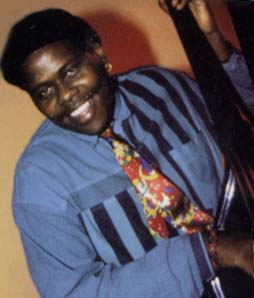
questions by Kevin Moore and Allan Johnston
interview conducted by María Victoria Mederos
Havana, Summer of 2001
©2001
PEDRO PABLO: In Monte Carlo we played traditional music and because we had no singer, the musicians danced and sang. When we came back to Cuba, NG was in all its splendor, and at that time I began playing the baby bass, as opposed to Feliciano Arango who played electric bass. I used a rhythm pattern that no one had used before, using the Mozambique formula for the Tumbaos in the bass. The introduction of the timbales also contributed to the change, because NG and the other new groups all used drum set. Charanga Habanera used timbales, the baby bass, and three trumpets. We changed the style for the tumbao of the piano player and added dance choreography to our performances. It was a different form, a new light in Cuban music.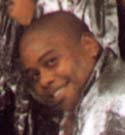
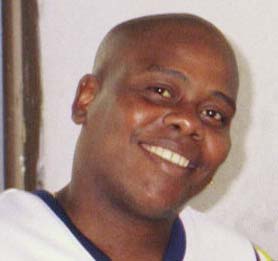
TIMBA.COM: In songs like "Hey You, Loca" and "Quítate el Disfraz", the bass and the bass drum play at different times, as if they¹re having a conversation. In most music that uses the drumset, the bass drum usually reinforces the bass part instead of playing polyphonically against it. How did this idea of giving separate parts to the bass and bass drum originate?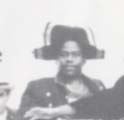
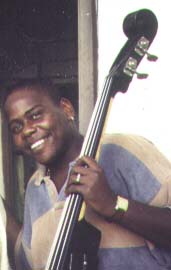
Part 2: questions from Allan Johnston, well-known bassist and author of “El estilo del bajo de Pedro Pablo Gutiérrez”
ALLAN: Tell us your current and future musical projects.















